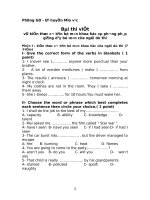Bài thi CAE (Reading - Part 2)
Bạn đang xem bản rút gọn của tài liệu. Xem và tải ngay bản đầy đủ của tài liệu tại đây (71.99 KB, 3 trang )
Part 2: Gapped Text
Instructions
You are going to read an extract from a book on networking and public speaking skills. Six paragraphs have been
removed from the extract. Choose from the paragraphs A-G the one which fits each gap (1-6). There is one extra
paragraph which you do not need to use.
TALKING TO PLANTS AND
APPROACHING GROUPS
In this book extract from “…and death came
third!” Andy Lopata and Peter Roper show
nervous business people how to network with
panache.
At networking events, I will often look to start a
conversation with people who are on their own. It is
much easier than breaking into a group conversation
and the chances are they won’t tell you to leave them
alone and go away. Very few people go to networking
events for solitude.
1
When approaching these people you are already at
an advantage because they will both respect your
courage (which they have probably lacked) and be
grateful that you’ve taken the time and effort to
relieve them from their anxiety. They are probably just
as nervous as everyone else, and they’ll be delighted
to get into a conversation with you. You’ve rescued
them from walking around, avoiding interrupting other
people for fear of rejection.
2
Having spoken to them, try not to leave them on their
own again because you’ll just return them to the
same state as you found them. Move on with them
and introduce them to someone else.
3
If someone is talking and you interrupt, or ask if you
can join them, people will stop listening to the person
who’s talking, and invite you into their group. That’s
great for you but not so nice for the person who is
talking. Stand just on the edge of the group and wait
for the appropriate time.
4
Alternatively, it may be that they’re talking about
something in which you have an interest, in which
case, when there’s an appropriate pause, you can
just say, “Excuse me, I heard you mention so-and-so.
Can I ask you a question? Are you involved in that?
And you’re in the conversation. Or it may just be that
you have a pause, and you ask “May I join you?” But
it’s always best to wait for the right pause in the
conversation.
A. The one thing I try to avoid is approaching two
people who are in discussion. If you see two people
talking together, they may be building a rapport and
interruption may break that. Alternatively, they may
be discussing business.
B. The easiest way to approach a group is to catch
the eye of one of the participants and smile. Usually
they should invite you to join them at the appropriate
juncture.
C. The other advantage of this is that your
companion, in introducing you, may well talk about
how you’ve helped them, how great you are at what
you do or praise you in another way that you would
not have been able to do. This will awaken a greater
interest in you from the new contact than may
otherwise have been possible.
D. You can often find these people around a bar or
buffet table (they’ve probably read the advice
above!) or by the walls. Nervous people on their own
seldom stand in the middle of a room unless they
are milling around trying to pluck up the courage to
approach someone. Often they will be admiring the
art on the walls or the flora in the room, which gives
you a nice topic with which to start a conversation.
E. When you do approach them, take care not to
dive in aggressively but be empathetic to their
nervous state. Ask them if they mind if you join them
before introducing yourself, rather than running up
asking “So, what do you do then?”
F. If you see a group of people talking, approach the
group, but don’t butt in. Remember, as Susan
Roane says in How to Work a Room, “There is a
difference between including yourself in other
people’s conversations and intruding on them.”
G. If their body language is ‘closed’, and they are
facing each other, you should avoid interrupting
them. If they are more ‘open’ and they are standing
at an angle that leaves room for another party in the
conversation, you are likely to be more welcome.
5
While the guidelines above are important, you need
to be aware of the body language of people talking to
each other and networking events. Whether in
couples or groups, people will always send very clear
signals about approachability by the way they are
standing.
6
Reading this body language may mean that you are
better advised approaching two people rather than a
group.









